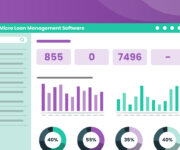Underwriting is an important process in lending operations. A lender’s ability to predict creditworthiness seals the fate of the loan. Whether it will be repaid promptly, or become a non-performing asset, or worse still result in loan fraud, is an outcome of underwriting efficiency.
Manual underwriting interventions are no longer sustainable, no matter how many resources companies invest in this process. Underwriting teams need access to the right technology to help companies keep pace with their goals of capturing greater market share while doing so swiftly and accurately.
The global loan origination software market, valued at $ 3.9 billion in 2021, is expected to grow to $ 9.5 billion by 2030.
Adoption of such cutting-edge credit underwriting software by forward-looking lenders can help them transform operations and keep pace with market demands.
In this blog, we outline key features in underwriting software, which value-add to a lender’s tech stack and help them gain a competitive edge in a crowded market.
What is Credit Underwriting Software?
A credit underwriting software is an end-to-end financial analysis solution, which aims to accurately gauge a borrower’s risk profile. A combination of technologies such as artificial intelligence (AI), Machine Learning (ML), cloud computing, automation and optical character recognition, has helped technology specialists develop a powerful solution to current lending challenges.
Use of this software is helping bring more efficiency and accuracy to the underwriting process. In turn, this approach reduces the risk of loan fraud and the rise of a lender’s Non-Performing Assets (NPAs). Low-risk, creditworthy borrowers can also be identified among a pool of loan applicants, who may or may not possess assets.
Today, a mix of banks, non-banking financial companies (NBFCs), and neo banks are leveraging underwriting software to solve their needs.
7 features of cutting-edge credit underwriting software
Here is a snapshot of the direction in which credit underwriting software is evolving. Lenders are advised to seek these attributes when choosing the right platform for their operations.
1. A User-friendly Interface
Underwriting teams tend to be made up of financial professionals and accountants, not techies. Hence, the interface needs to be user-friendly. Members of the underwriting team must be able to leverage the software, with ease, and arrive at underwriting decisions, quickly.
They must be able to reach out to the platform’s customer service quickly, in case of issues, and get solutions to ongoing challenges.
2. Cloud capabilities
A lender’s platform of choice must come with cloud capabilities. The best approach is to choose a platform that comes with a subscription-based pricing model. In this case, lenders are not stuck with the need to buy and upkeep on-premises software and hardware.
This is a cost-effective solution that stores data securely and makes it accessible on demand. With the adoption of hybrid and remote work, lenders can offer authorised access to team members in geographical locations, thus simplifying workflows.
Teams can work collaboratively, in real-time on the same projects, and close loan applications, quickly.
3. End-to-end Bank Statement Analysis
A key deliverable of lending software is that it must be able to paint a comprehensive and realistic picture of a borrower’s financial status. The bank statement analysis is completely automated from end-to-end, right from automated data entry to offering a creditworthiness score for every borrower.
This process eliminates several manual processes traditionally performed by underwriting teams, thus completely freeing up their bandwidth for higher-value decision-making.
4. Stellar Fraud Detection Capabilities
Another benefit of superior lending software is that it must be able to help lenders predict potential fraud early on. The software does this in multiple ways.
For instance, it must be able to detect unusual patterns in transactions which could be reg flags for irregular activities. It must be able to detect inconsistencies in documentation, which can be a red flag for fraudulent documents.
Identity fraud is another type of loan fraud where a borrower is impersonating another individual or business. A good lending software can weed out inconsistencies in nomenclatures, and other telltale signs.
5. Customisation of dashboards
A key benefit of credit underwriting software is that all transactions can be segregated into inflow and outflow categories, and further on under categories such as salaries, EMI repayments, and revenues.
Hence underwriters can leverage an extensive amount of well-categorised data to understand borrower trends and needs in detail.
This is a valuable resource to help businesses formulate strategies to grow their businesses and establish realistic goals.
6. Implementation of Compliance Requirements
With financial regulatory authorities constantly introducing new guidelines, lenders must be able to implement these requirements with little effort.
A no-code lending software enables underwriters to make adjustments without needing to write fresh code, every time there is a change.
This is an important feature, as adherence to compliance translates to money saved in terms of penalties, as well as avoidance of a permanent shutdown due to non-compliance.
7. Evaluate Potential to Scale
As businesses continue to scale, the lending software must be able to keep pace with its scalability needs. However, some lending solutions lack the flexibility to shift seamlessly between a small operation to a massive one.
Lenders are forced to choose one or the other to meet their real-time needs.
However, shifting from one ending software to another is not a sustainable shift. The best approach is to partner with a technology specialist, which offers flexibility of scale within the same platform.
Borrowers can seamlessly go from 50 borrowers to 50,000 and beyond, based on the pivot. The subscription costs will vary based on real-time needs, but this is the most cost-effective option.
The Takeaway
Smart use of tech-enabled solutions such as credit underwriting software, can help businesses streamline their operations. They can predict potential loan fraud and NPAs, and increase their audience pool with effective underwriting processes.
Lenders can partner with a technology specialist, and access the best technological solutions for their express needs.
Finezza offers a comprehensive set of tools and solutions to manage your lending portfolio. Our end-to-end lending management solutions are trusted by brands like ftcash, Hiranandani Financial Services, gromor Finance, and UC Inclusive Credit, to name a few.
Finezza’s intuitive bank statement analysis software is geared to analyze bank statements with speed, and accuracy and detect potential fraud.
Book a demo to know more.




Leave a Reply